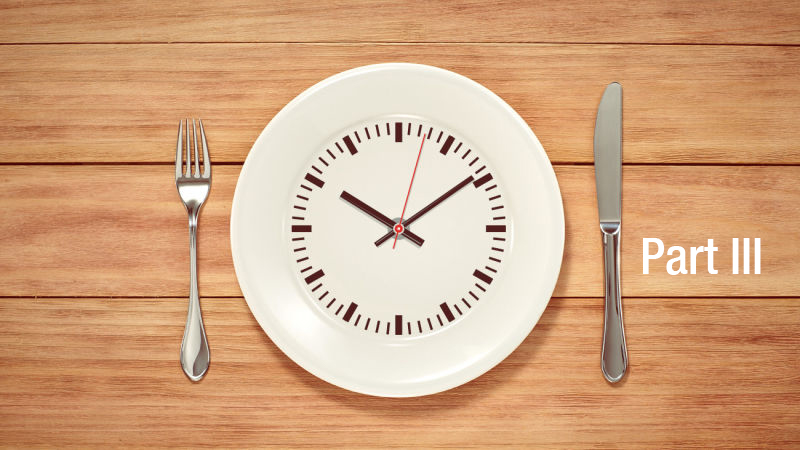In Part I of my intermittent fasting series I detailed the potential health benefits of intermittent fasting. In Part II I detailed why intermittent fasting is such a powerful tool to aid in safe and permanent weight loss. Here in Part III, I will outline the two most popular fasting frequencies and the three most common fasting lengths.
Fasting Frequency
The two most popular and commonly used fasting frequencies involve either fasting every other day or fasting two days a week.
Alternate Day Fasting
Fasting every other day is referred to as alternate day fasting or ADF for short. ADF is the most clinically researched form of intermittent fasting and involves eating normally one day and then utilizing either a 24 hour fast or 36 hour fast the next day.
The primary benefits to using an ADF regime are that users get a minimum of 3 days a week to reap the health benefits of a heavily reduced or completely eliminated caloric intake. Second, going a minimum of three days a week ingesting so few calories leads to a sizable weekly caloric deficit, which can profoundly aid in weight loss.
The primary drawback to using an ADF regime is that some users of ADF methods have found them too demanding and difficult. Thus long term compliance with ADF regimes often fall off in time.
5:2 Fasting
Fasting twice a week, a method popularized by the book “The Fast Diet” written by Michael Mosley and Mimi Spencer, is called a 5:2 regime. When using a 5:2 regime you eat normally five days a week and then incorporate either a 24 hour or 36 hour fast on two non-consecutive days, preferably with more than one day in between.
While a 5:2 regime does not provide as many days of reduced caloric intake per week as an ADF regime does, and the extra health and weight loss benefits that come from these extra days, the 5:2 regime has been shown to be far less difficult to maintain than ADF regimes and thus far more sustainable for the long term.
Fasting Length
The three most commonly used fasting lengths are 16 hour fasts, 24 hour fasts, and 36 hour fasts.
16 Hour Fasting
When fasting for 16 hours you limit your food intake to a consistent 8 hour window throughout the course of each day. For example you may decide to eat between 8am and 4pm, but not after that. Or you may decide not to eat before 12pm and after 8pm. However it is important to stick to that same schedule each day so that you are able to consistently achieve a 16 hour fast between one day’s final meal and the next day’s first.
The primary benefit of a daily 16 hour fast is that it is the least uncomfortable of the fasting lengths. You get to eat at least two meals every day and are hit with fewer hunger pangs. The primary drawback of a 16 hour fast is that most of the health benefits seen with fasting don’t reach their higher levels until 24 hours into the fast. Thus by fasting for only 16 hours you won’t maximize the health benefits of fasting.
24 Hour Fasting
When fasting for 24 hours, individuals most commonly choose to either skip breakfast and lunch or lunch and dinner, creating a 24 hour period between one day’s final meal and the next day’s first meal. Some individuals will also choose to skip dinner one day and breakfast the next, achieving their 24 hour fast between each day’s lunches.
The primary benefits of a 24 hour fast are that you are able to achieve a sizable caloric deficit and begin to see the full health benefits that can be achieved with fasting. The primary drawback of fasting for 24 hours is that it normally involves a day where you are only able to eat one meal. This can become challenging for some and will require higher levels of developed discipline and focus.
36 Hour Fasting
By far the most common way to achieve a 36 hour fast is to simply not eat anything for one entire day. By doing so you will have gone without food from dinner one day, throughout the second, and until breakfast the third. A time period that usually comes out to around 36 hours.
The primary benefits of a 36 hour fast are the same as a 24 hour fast, but taken even further. 36 hours without food achieves an even larger caloric deficit and 36 hours without food helps maximize the health benefits seen from intermittent fasting. The primary drawback with a 36 hour fast is that it involves going an entire day without ingesting anything other than water and coffee and this can be particularly challenging.
Rounding It Up
As we can see, each fasting frequency and each fasting length provides a different degree of benefits, but also carries a different degree of difficulty.
When you begin a fasting regime for the first time, choose your fasting frequency and length conservatively. For instance an ADF regime and fasting for 36 hours may be too aggressive to start. Try a 5:2 regime with 24 hour fasts first. Once that has become manageable then try increasing your fast length to 36 hours. Once that has become manageable then try an ADF regime.
Taking it slow greatly increases the ability to stay committed to your fasting program and in time, build up the mental fortitude that will make fasting easy.
To Our Health
Zach





